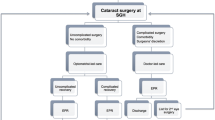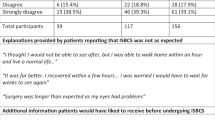Abstract
Aims/Background: Many preoperative ophthalmic and medical tests lack proven effectiveness in the evaluation of cataract surgery patients. Variation in use has been described in the USA, but little information is available for countries with different health systems. The objectives of the study were to assess variation in ophthalmologists' use of preoperative testing on cataract surgery patients and to identify ophthalmologists' characteristics associated with it. Methods: A postal survey was made in a representative sample (response rate of 70%) of the Barcelona Medical Association of Ophthalmologists performing cataract surgery during 1993 (N = 89). The questionnaire included information about common preoperative, intraoperative and postoperative practice and sociodemographic and professional data. Appropriateness of preoperative ophthalmic tests was classified in 3 levels (indicated tests, tests with unproven benefit, and non-indicated tests) according to recommendations of the Cataract Management Guideline Panel [1] and the American Academy of Ophthalmology Preferred Practice Pattern [2]. Results: Almost all the ophthalmologists reported performing Fundus exam plus A-scan in the preoperative evaluation of cataract surgery patients (indicated tests). Up to 20% reported performing ‘frequently’ or ‘always’ some non-indicated or unproven benefit ophthalmic tests. Additionally, an average of 7 medical tests were ‘routinely’ included. Private practice and cataract subspeciality were the ophthalmologists' characteristics more frequently associated with the use of inappropriate ophthalmic tests (p < 0.05). Conclusions: In Barcelona, Spain, some ophthalmic tests of unproven effectiveness are frequently performed preoperatively on cataract surgery patients without ocular comorbidity. Also, a generalized utilization of several medical tests was reported. There is potential for some cost containment and more appropriate care of cataract patients without diminishing the quality of care, in a location with low surgery rates.
Similar content being viewed by others
References
Cataract Management Guideline Panel. Cataract in adults: management of functional impairment. Clinical Practice Guideline, Number 4, Rockville, MD, U.S. Department of Health and Human Services, Public Health Service, Agency for Health Care Policy and Research. AHCPR Pub No 93-0542; 1993.
The American Academy of Ophthalmology Quality of Care Committee, Anterior Segment Panel. Preferred practice pattern: cataract in the otherwise healthy adult eye, San Francisco, Calif, American Academy of Ophthalmology; 1989.
Steinberg EP, Javitt JC, Sharkey PD et al. The content and cost of cataract surgery. Arch Ophthalmol 1993; 111: 1041–9.
Steinberg EP, Bergner M, Sommer A et al. Variations in cataract management: patient and economic outcomes. Health Serv Res 1990; 25: 727–31.
Altes dels hospitals d'aguts de Catalunya 1993. Informe del registre del Conjunt Mínim Bàsic de Dades de l'Alta Hospitalària (CMBDAH), Barcelona, Dept. de Sanitat i Seguretat Social, Generalitat de Catalunya; 1994.
Steinberg EP, Bass EB, Luthra R et al. Variation in ophthalmic testing before cataract surgery. Results of a national survey of ophthalmologists. Arch Ophthalmol 1994; 112: 896–902.
Bass EB, Steinberg EP, Luthra R et al. Variation in ophthalmic testing prior to cataract surgery. Results of a national survey of optometrists. Cataract Patient Outcome Research Team. Arch Ophthalmol 1995; 113: 27–31.
Oshika T, Masuda K, Hayashi F, Leaming DV. Current trends in cataract and refractive surgery in Japan — 1992 survey. Jpn J Ophthalmol 1993; 37(4): 432–44.
Leaming DV. Practice styles and preferences of ASCRS members — 1993 survey. J Cataract Refract Surg 1994; 20: 459–67.
Bellan L. Preoperative testing for cataract surgery. Can J Ophthalmol 1994; 29: 111–4.
Williams MH, Frankel SJ, Nanchahal K, Coast J, Donovan JL. Cataract surgery. In: Stevens A, Raftery J (eds) Health care needs assessment (I). Oxford, Radcliffe Medical Press 1994: 591–687.
Bernth-Petersen P, Bach E. Epidemiologic aspects of cataract surgery. II: Regional variation in frequencies. Acta Ophthalmol (Copenh) 1983; 61: 397–405.
Hodgkins PR, Luff AJ, Morrell AJ, Teye Botchway L, Featherston TJ, Fielder AR. Current practice of cataract extraction and anaesthesia. Br J Ophthalmol 1992; 76: 323–6.
Blery C, Charpak Y, Szatan M et al. Evaluation of a protocol for selective ordering of preoperative tests. Lancet 1986; 1: 139–41.
Kaplan EB, Sheiner LB, Boeckmann AJ et al. The usefulness of preoperative laboratory screening. JAMA 1985; 253: 3576–81.
Kaplan EB, Boeckmann AS, Roizen MF, Sheiner LB. Elimination of unnecessary preoperative laboratory tests. Anesthesiology 1982; Suppl 57(3): A445.
Johnson H Jr, Knee-Ioli S, Butler TA, Munoz E, Wise L. Are routine preoperative laboratory screening tests necessary to evaluate ambulatory surgical patients? Surgery 1988; 104: 639–45.
Roizen ME The compelling rationale for less preoperative testing [editorial]. Can J Anaesth 1988; 35: 214–8.
Roizen MF, Kaplan EB, Schreider BD, Lichtor LJ, Orkin FK. The relative roles of the history and physical examination, and laboratory testing in preoperative evaluation for outpatient surgery: the ‘starling’ curve of preoperative laboratory testing. Anesthesiol Clin North Am 1987; 5(1): 15–35.
Turnbull JM, Buck C. The value of preoperative screening investigations in otherwise healthy individuals. Arch Intern Med 1987; 147: 1101–5.
Les altes dels hospitals d'aguts de Catalunya, 1982 i 1985. Informes estadístics d'assistència sanitària-2, Barcelona, Dept. de Sanitat i Seguretat Social, Generalitat de Catalunya; 1989.
Bass EB, Steinberg EP, Luthra R et al. Do ophthalmologists, anesthesiologists, and internists agree about preoperative testing in healthy patients undergoing cataract surgery? Arch Ophthalmol 1995; 113: 1248–56.
Gilvarry A, Eustace P. The medical profile of cataract patients. Trans Ophthal Soc UK 1982; 102: 502–4.
Godlee F. The Cochrane collaboration [editorial]. BMJ 1994; 309: 969–70.
Author information
Authors and Affiliations
Consortia
Rights and permissions
About this article
Cite this article
Espallargues, M., Alonso, J., Castilla, M. et al. Preoperative testing practice in healthy cataract surgery patients. Results of a survey of ophthalmologists in Barcelona, Spain. Int Ophthalmol 20, 315–322 (1997). https://doi.org/10.1007/BF00176884
Accepted:
Issue Date:
DOI: https://doi.org/10.1007/BF00176884




